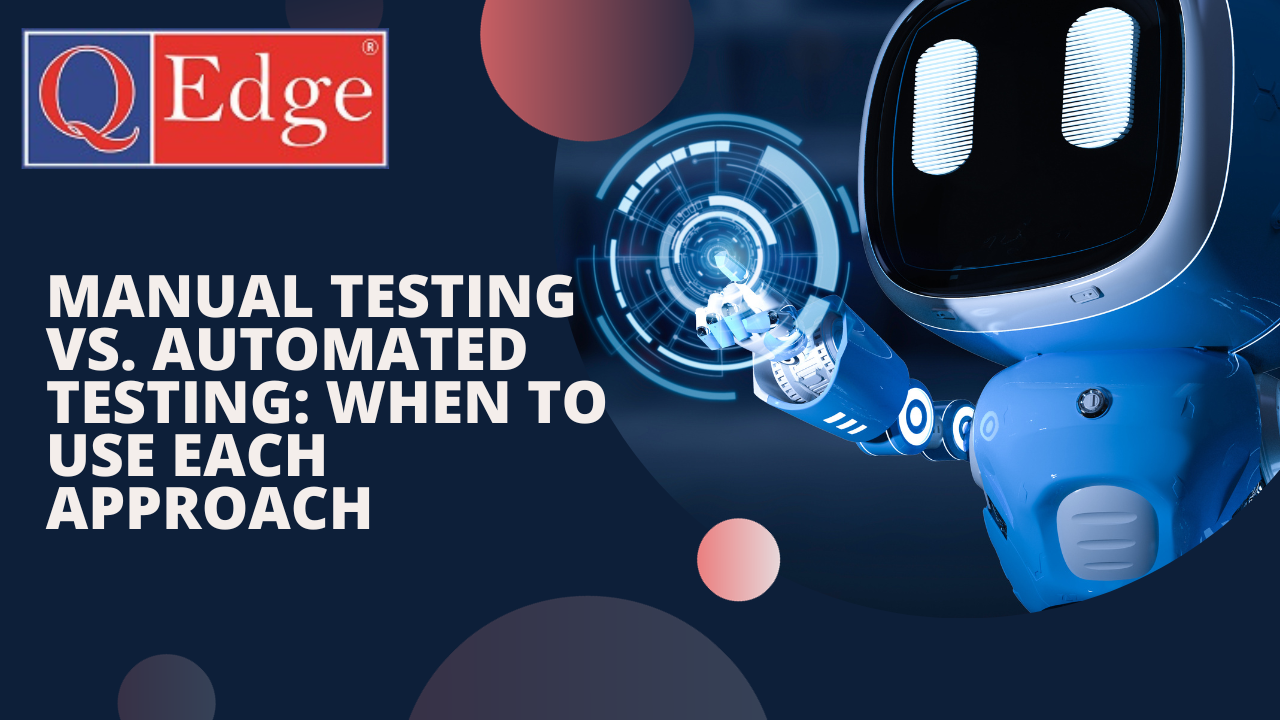Manual Testing vs. Automated Testing: When to Use Each Approach

Manual Testing vs. Automated Testing: When to Use Each Approach
Introduction:
Software testing is a critical part of the software development lifecycle, ensuring the quality and reliability of applications. Manual testing and automated testing are two primary approaches used for testing software. Aspiring professionals can gain expertise in manual testing through a manual testing online course. In this article, we will compare manual testing and automated testing, explore their strengths and weaknesses, and discuss when to use each approach.
- Understanding Manual Testing:
Manual testing is a testing approach where testers manually execute test cases, analyze system behavior, and compare actual results against expected outcomes. It relies on human intuition, creativity, and domain knowledge to identify defects and ensure the software meets the desired requirements. Manual testing involves verifying user interfaces, data validation, system functionality, and user experience through hands-on testing. - Understanding Automated Testing:
Automated testing involves using software tools to execute pre-scripted test cases and compare actual results with expected outcomes. Test scripts are created to simulate user interactions, perform specific actions, and validate system behavior automatically. Automated testing is efficient for repetitive and time-consuming tasks, allowing testers to focus on more complex scenarios and areas that require human intuition. - Strengths of Manual Testing:
Manual testing offers several strengths that make it a valuable approach in certain situations:
- Exploratory Testing: Manual testing allows testers to explore the system, think creatively, and uncover hidden defects that may not be covered by predefined test cases. Testers can adapt their approach based on real-time observations and make quick decisions.
- Usability Testing: Manual testing is effective for evaluating the user experience and usability aspects of software applications. Testers can provide subjective feedback on the software’s intuitiveness, ease of use, and overall user satisfaction.
- Ad Hoc Testing: Manual testing is suitable for scenarios that require ad hoc testing, such as quickly testing a new feature or bug fix. Testers can perform on-the-spot testing without the need for predefined test cases or scripts.
- Early Bug Detection: Manual testing helps identify defects early in the software development lifecycle. Testers can catch issues that may not be captured by automated tests, such as visual inconsistencies, layout problems, or complex business rules.
- Strengths of Automated Testing:
Automated testing provides several advantages that make it suitable for certain types of testing scenarios:
- Regression Testing: Automated testing is highly efficient for repetitive regression testing, ensuring that previously fixed defects do not reoccur. It allows testers to rapidly execute a large number of test cases and compare results against known baselines.
- Performance Testing: Automated testing tools can simulate thousands of user interactions, providing accurate measurements of system performance and response times. It enables testers to identify performance bottlenecks, stress test the system, and analyze the impact of load on application performance.
- Data-Driven Testing: Automated testing supports data-driven testing, allowing testers to run test cases with multiple data sets. This approach helps ensure comprehensive coverage and accelerates the testing process.
- Complex Scenarios: Automated testing is effective for testing complex scenarios that require precise input combinations, invalid data handling, or intricate business rules. Testers can easily create and manage test scripts, reducing the chances of human error.
- When to Use Manual Testing:
Manual testing is most suitable in the following situations:
- Exploratory Testing: When testers need to explore the application and uncover hidden defects that may not be covered by predefined test cases.
- Usability Testing: When evaluating the user experience, intuitiveness, and overall usability of the software application.
- Ad Hoc Testing: When quick testing is required, such as for testing new features, bug fixes, or areas with frequent changes.
- Early Bug Detection: When early detection of visual defects, layout inconsistencies, or complex business rules is crucial.
- When to Use Automated Testing:
Automated testing is most suitable in the following scenarios:
- Regression Testing: When repetitive testing is required to ensure that previously fixed defects do not reoccur.
- Performance Testing: When measuring system performance, response times, and scalability under various load conditions.
- Data-Driven Testing: When running test cases with multiple data sets to ensure comprehensive coverage.
- Complex Scenarios: When testing complex scenarios that involve intricate business rules, precise input combinations, or invalid data handling.
- Gaining Expertise through a Manual Testing Online Course:
To excel in manual testing, professionals can enhance their skills and knowledge through a manual testing online course. These courses provide comprehensive training on manual testing techniques, methodologies, best practices, and industry-standard tools. By enrolling in such a course, individuals can learn how to effectively design, execute, and manage manual tests, ensuring optimal quality and reliability of software applications.
Conclusion:
Manual testing and automated testing are two essential approaches in software testing. Each approach has its own strengths and weaknesses and is suitable for specific testing scenarios. Manual testing is ideal for exploratory testing, usability testing, ad hoc testing, and early bug detection. On the other hand, automated testing is efficient for regression testing, performance testing, data-driven testing, and testing complex scenarios. By understanding when to use each approach, professionals can ensure comprehensive testing coverage and deliver high-quality software applications. Enrolling in a manual testing online course enables individuals to gain expertise in manual testing methodologies, tools, and techniques, contributing to the development of reliable and user-friendly software systems.
